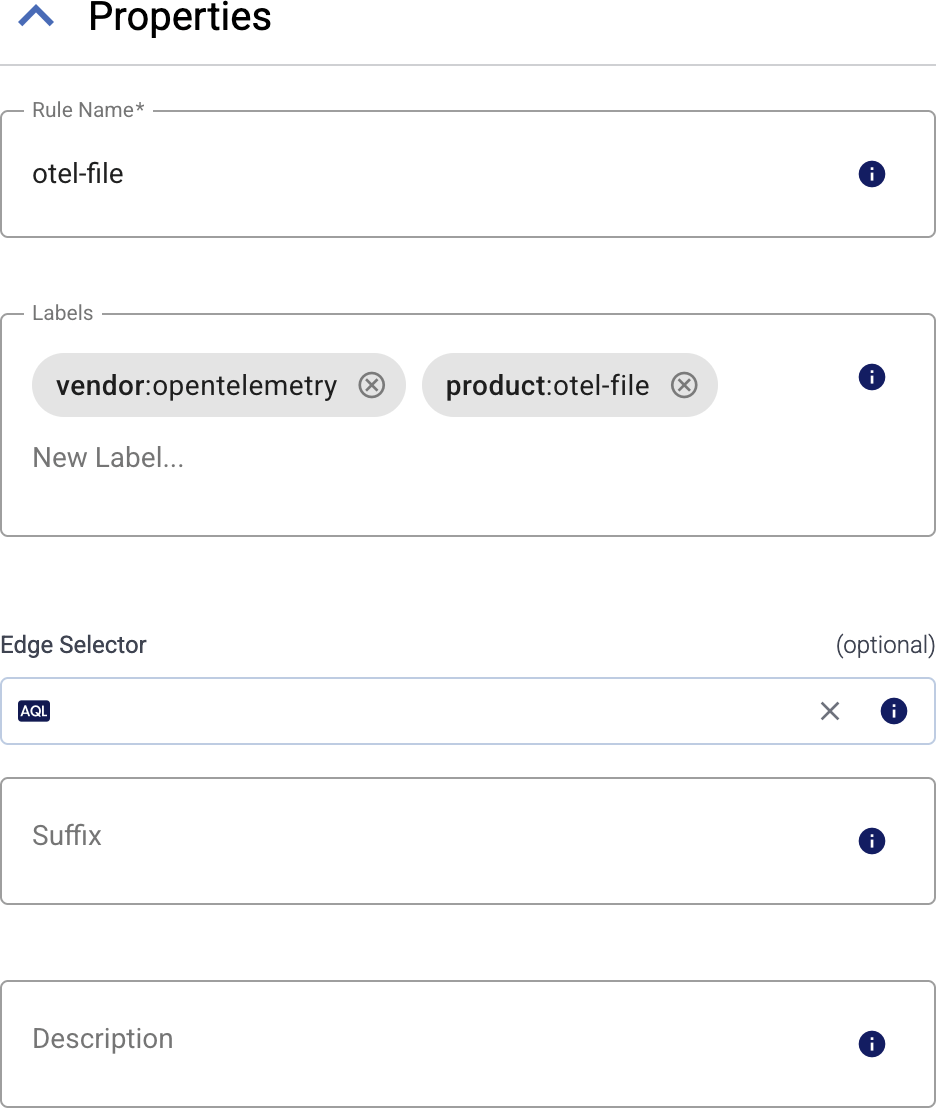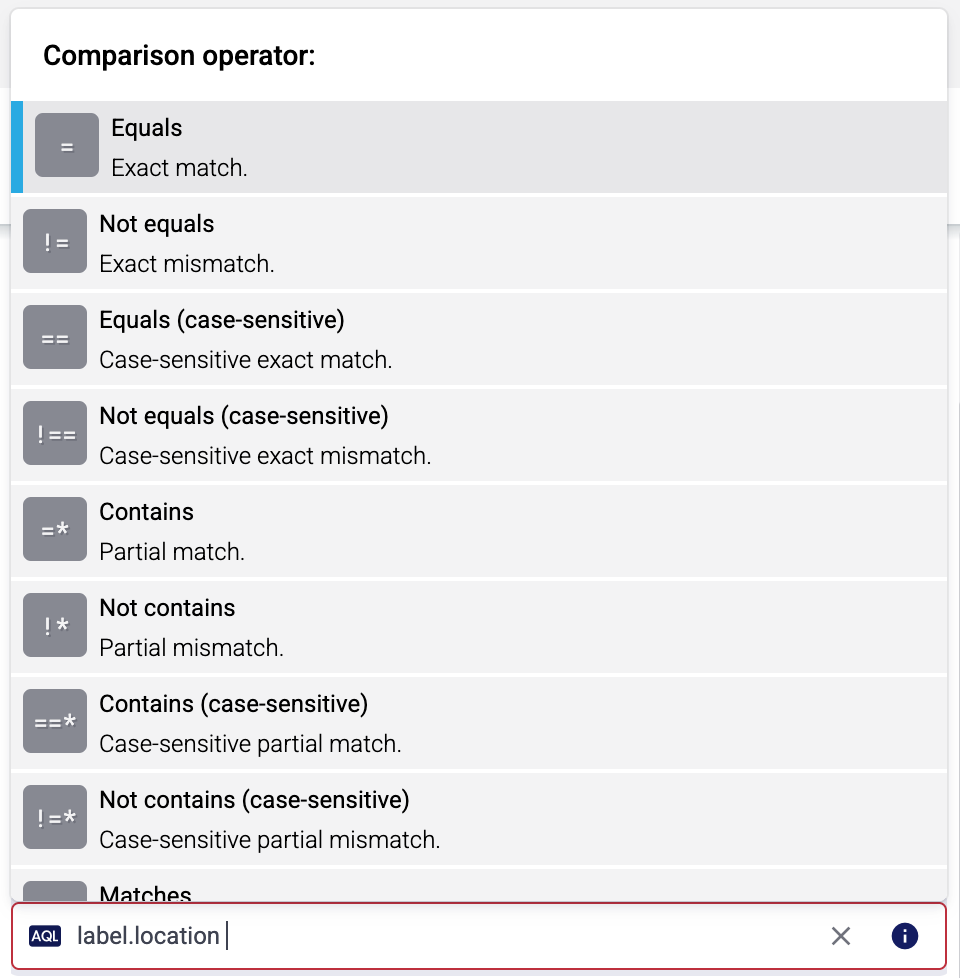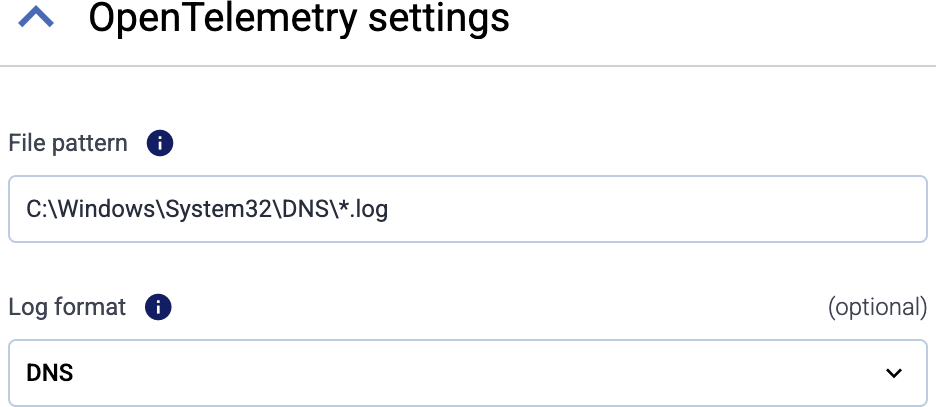File Collector
Collect logs from a local file that’s available on the edge host.
Prerequisites
This collector can be deployed to edge hosts running Axoflow agent for Linux and Axoflow agent for Windows.
Add new File Collector
To create a new Collection Rule that collects data from files on edge hosts, complete the following steps:
-
Select Sources > Collection Rules > Add Rule. (Alternatively, you can select Add Collector > Create a collection rule on the Collectors page of an edge host.)

-
Select File Collector.
-
Configure the connector rule.
-
Enter a name for the collection rule into the Rule Name field.

-
(Optional) Add labels to the collection rule.
You can use these metrics labels as:
- Filter labels on the Analytics page
- in the Filter By Label field during log tapping
- in Flow Processing steps, for example, in the Query field of Select Messages steps.
-
Set the Edge Selector for the collection rule. The selector determines which edge hosts will have an edge connector based on this collection rule.

- Only edge hosts will match the rule.
- If you leave the Edge Selector field empty, the rule will match every edge host.
- To select only a specific host, set the
namefield to the name of the host as selector. - If you set multiple fields in the selector, the collection rule will apply only to edge hosts that match all elements of the selector. (There in an AND relationship between the fields.) For example,
label.location = us-east-1 AND label.product = windows
-
(Optional) Enter a Suffix for the collection rule. This suffix will be used in the name of the edge connector instances created on the edge hosts. For example, if the name of a matching edge host is “my-edge”, and the suffix of the rule is “otel-file-collector”, the edge connector created for the edge will be named “my-edge-otel-file-collector”.
If the Suffix field is empty, the name of the collection rule is used instead.
-
(Optional) Enter a description for the rule.
-
-
Enter the path of the log file, or a pattern to match multiple files into the File pattern field, for example:
C:\Windows\System32\DNS\dns.logor/path/to/**/*.log
You can use the following special characters:
-
*: Matches one or more characters that aren’t path separators. -
/**/: Matches zero or more directories. -
?: Matches a single non-path-separator character. -
[class]: Matches any single non-path-separator character from the specified class. The following classes are available:[abc123]: Matches any single character of the specified characters.[a-z0-9]: Matches any single alphanumeric character in the range of a-z or 0-9.[^class]or[!class]: Negates the class, so it matches any single character which does not match the class.
-
-
(Optional) If needed, set advanced options under More options.
-
To apply a specific parser on the messages of the log file, select it from the Log format field. Currently Windows DNS and DHCP log files are supported.11
-
Select Add. Based on the collection rule, Axoflow automatically creates edge connectors on the edge hosts that match the Edge Selector.
CAUTION:
Make sure to configure Data Forwarding Rules for your edge hosts to transfer the collected data to the OpenTelemetry connector of an AxoRouter.
Related metrics
You can use these metrics labels as:
- Filter labels on the Analytics page
- in the Filter By Label field during log tapping
- in Flow Processing steps, for example, in the Query field of Select Messages steps.
| label | value |
|---|---|
| edge_connector_name | The name of the edge connector that collected the message |
| edge_connector_type | otelFile |
| edge_connector_label_ | Labels set on the edge connector. By default: vendor:opentelemety, product:otel-file |
| edge_connector_rule_id | The ID of the owner ConnectorRule resource in Axoflow that created the edge connector. |
| edge_flow_name | The name of the edge forwarding rule that sent the message. |
Advanced options
-
Exclude file pattern: Exclude some files that match the File pattern. You can use the same special characters as in the File pattern field.
-
Exclude older than: Exclude files whose modification time is older than the specified value, for example:
1h,24h,7d. -
Multi-line start pattern: Regex pattern to identify the start of a multi-line log entry. Mutually exclusive with Multi-line end pattern.
-
Multi-line end pattern: Regex pattern to identify the end of a multi-line log entry. Mutually exclusive with Multi-line start pattern.
-
Multi-line omit pattern: If enabled, the lines matching the multiline pattern are omitted from the entry.
-
Force flush period: Always flush the current batch if the after the specified period. Example values:
1s,5m,1h. Default value:500ms -
Encoding: Specifies the encoding of the file being read. Default value:
utf-8. The following values are supported:nop: No encoding validation. Treats the file as a stream of raw bytesutf-8: UTF-8 encodingutf-8-raw: UTF-8 encoding without replacing invalid UTF-8 bytesutf-16le: UTF-16 encoding with little-endian byte orderutf-16be: UTF-16 encoding with big-endian byte orderascii: ASCII encodingbig5: The Big5 Chinese character encoding
-
Poll interval: The duration between filesystem polls, for example:
1s,5m,1h. Default value:200ms -
Initial buffer size: The initial size (in KiB) of the buffer to read file headers and logs. The buffer will grow as needed; larger values may cause unnecessary memory allocation, while smaller values may require multiple copies during growth. Default value:
16KiB -
Max log size: Maximum size of a log entry in megabytes. Larger log entries will be truncated. Default value:
1MiB -
Max batches: Maximum number of batches to keep in memory; applicable only when more than
1024files match the File pattern. -
Retry on failure max elapsed time: Maximum time (including retries) to send a log batch to a downstream consumer before discarding it, for example:
1s,5m,1h. Retrying never stops if set to0. Default value0 -
Compression: Specifies the compression format of the files being read. Possible values are the empty string,
gzip, andauto. Useautowhen your File pattern matches a mix of compressed and uncompressed files. -
Start at: Specifies where to start reading logs on startup:
beginningorendof the file. Default value:beginning